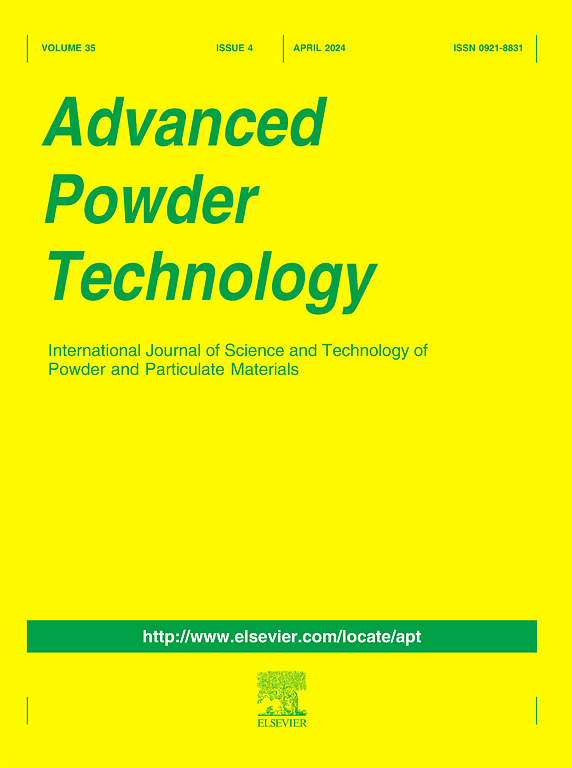液氮冷浸对砂岩铀矿石原位浸出孔隙结构及分形特征的影响
IF 4.2
2区 工程技术
Q2 ENGINEERING, CHEMICAL
引用次数: 0
摘要
本研究探索了一种绿色高效的液氮压裂方法。首先对砂岩铀矿石进行液氮冷浸处理,然后利用低温氮吸附(LTNA)、核磁共振(NMR)和扫描电镜(SEM)分析其孔隙和断裂结构的演化。探讨了孔隙结构的分形特征及其演化机制。结果表明:随着冷浸时间的延长和循环次数的增加,矿石中的气体吸附量增加;浸泡时间为180 min时氮吸附量最高,达到15.8556 cm3/g。经过15次冷冻循环后,氮气吸附量达到14.8818 cm3/g。微孔比例降低,中孔和大孔比例增加。其中,液氮浸泡180 min后,微孔减少9.59%,中孔增加7.79%,大孔增加1.8%。15次循环后,微孔减少10.55%,中孔增加6.38%,大孔增加4.17%。SEM观察证实,液氮处理扩大了现有孔隙和裂纹,并产生了新的裂缝。分形维数分析表明,液氮处理降低了矿石的分形维数,有效地提高了砂岩矿石的渗透率,促进了铀的浸出。本文章由计算机程序翻译,如有差异,请以英文原文为准。

Effect of liquid nitrogen cold soaking on the pore structure and fractal characteristics during in situ leaching of sandstone uranium ores
In this study, a green and efficient liquid nitrogen fracturing method was explored. Sandstone uranium ore was first treated with liquid nitrogen cold soaking, followed by an analysis of the evolution of its pore and fracture structure using Low temperature nitrogen adsorption(LTNA), Nuclear magnetic resonance (NMR), and Scanning electron microscopy (SEM). The fractal characteristics of the pore structure and its evolution mechanism were also examined.The results show that gas adsorption in the ore increased with longer cold soaking times and more cycles.The highest nitrogen adsorption capacity was observed at a soaking time of 180 min, reaching 15.8556 cm3/g. Additionally, after 15 freezing cycles, the nitrogen adsorption capacity reached 14.8818 cm3/g. The proportion of micropores decreased, while mesopores and macropores increased. Specifically, after 180 min of liquid nitrogen soaking, micropores decreased by 9.59 %, mesopores increased by 7.79 %, and macropores increased by 1.8 %. After 15 cycles, micropores decreased by 10.55 %, mesopores increased by 6.38 %, and macropores increased by 4.17 %. SEM observations confirmed that the liquid nitrogen treatment expanded existing pores and cracks, and generated new fractures.Fractal dimension analysis revealed that liquid nitrogen treatment reduced the fractal dimension of the ore.This study effectively improves permeability and promotes uranium leaching in sandstone ores.
求助全文
通过发布文献求助,成功后即可免费获取论文全文。
去求助
来源期刊

Advanced Powder Technology
工程技术-工程:化工
CiteScore
9.50
自引率
7.70%
发文量
424
审稿时长
55 days
期刊介绍:
The aim of Advanced Powder Technology is to meet the demand for an international journal that integrates all aspects of science and technology research on powder and particulate materials. The journal fulfills this purpose by publishing original research papers, rapid communications, reviews, and translated articles by prominent researchers worldwide.
The editorial work of Advanced Powder Technology, which was founded as the International Journal of the Society of Powder Technology, Japan, is now shared by distinguished board members, who operate in a unique framework designed to respond to the increasing global demand for articles on not only powder and particles, but also on various materials produced from them.
Advanced Powder Technology covers various areas, but a discussion of powder and particles is required in articles. Topics include: Production of powder and particulate materials in gases and liquids(nanoparticles, fine ceramics, pharmaceuticals, novel functional materials, etc.); Aerosol and colloidal processing; Powder and particle characterization; Dynamics and phenomena; Calculation and simulation (CFD, DEM, Monte Carlo method, population balance, etc.); Measurement and control of powder processes; Particle modification; Comminution; Powder handling and operations (storage, transport, granulation, separation, fluidization, etc.)
 求助内容:
求助内容: 应助结果提醒方式:
应助结果提醒方式:


